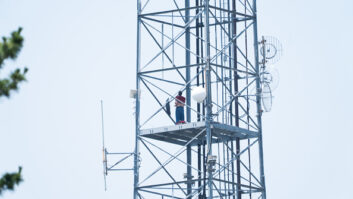
Clarence Kane plies his trade of more than three decades of microphone repair.
PITMAN, N.J. — Clarence Kane possesses a skill set that makes him rather unique in age of “if it’s broke, throw it away” and “nothing’s made in America anymore.”
He repairs ribbon (or, more correctly, velocity) microphones, and has been doing so for more than 30 years. Kane’s customers have included Les Paul, Chet Atkins and Pixar Animation Studios.
While Kane repairs and rebuilds all types of ribbon mics, the overwhelming majority of his business centers around classis RCA issues, even though the last of these was sold more than 30 years ago.
Business is good. On average, Kane rehabs two microphones per week, or around 100 per year.
The curious thing is that he didn’t start out as a microphone repairman. In 1946, when he signed up for GI Bill classes at the Radio Electronics Institute in Philadelphia, he wouldn’t have thought he’d ever have much if anything to do with mics.
“I was hired by RCA in 1952 and wanted to be a lab technician or wireman for the company,” Kane said. “After I finished my two-year electronics training, I worked for a scientific glass firm and then installed TV sets and antennas for a furniture store. I even worked for a while with a contractor in building houses.”
Kane’s career track changed with his association with RCA, as he eventually became a field rep, traveling around the country — and the world — as part of the company’s service organization, installing broadcast equipment at radio and television stations.
“I worked on installing gear at places like WPIX, KTVU and WCAU,” Kane said. “In one case, I put in a complete FM station on the upper floor of a private home that was being used as a business office by a Realtor who wanted to go into radio.”
Mic repair
Kane’s career shifted again in the 1970s as RCA’s business began to change.

This machine was created to corrugate the ultra-thin aluminum strips used in ribbon microphones. It dates to the 1930s and is still used by Kane to fabricate replacement ribbons.

Kane’s microphone collection includes this rare RCA KB-2A ‘paintbrush’ model.
“The company had kept seven or eight people — mostly women — busy repairing microphones, but by the late ’70s, that part of the business was really falling off.
“I was working on things like TP-7 projectors then and was occasionally assigned to help out with microphone repair. Finally, I was asked if I would do this on my own time, with RCA referring their microphone customers to me. I repaired microphones on the weekends.”
In 1986, RCA’s overall business and financial state had declined to the point that led to the takeover of the company by General Electric. Kane decided that this was a good time to part with the firm that had been his employer for some 34 years.
He purchased all of the remaining specialty microphone tools and parts, including the extremely thin aluminum material used as the element in such microphones as the 44s, 74s, 77s and BK-5s. The “ribbon” was sold in “books” of 20 sheets each and is a mere 1/10,000 of an inch thick. Even though Kane has been using this supply steadily since starting his own company in 1986, he still has a bountiful supply.
ENAK Microphone Repair (the acronym is Kane spelled backwards) started out sharing space with an audio company in a commercial building; when the other operation moved out, Kane couldn’t justify the large space and relocated the mic repair business to his home in this small New Jersey town.
Original equipment

The announcement from RCA’s chief of sale, Don Massa, announcing the end of the line for the company’s popular 77DX microphone. He recommended steering business to Electro-Voice and its RE15 mic.
Kane still uses the same repair bench at which he worked 40 years ago in RCA’s broadcast division in Camden, N.J. and has plenty of room for the tools of his trade.
These include a small “anechoic chamber” for sweep testing mics, the original hand-powered machine first used in the 1930s for corrugating aluminum ribbons for the first velocity microphones designed by RCA’s legendary audio guru, Harry F. Olson, as well as a number of special dies for cutting ribbon material to exact size for a variety of mics.
Kane has most of RCA’s ribbon mic documentation too, including engineering blueprints for the model 44A, which dates to 1932.
Even though the last of the RCA 77s was sold in 1978, there is still a great demand for the microphone, due to its unique double-domed shape and its performance characteristics. (It appeared as the desk mic during Johnny Carson’s reign over the “Tonight” show and is seen on “Larry King Live.”) This particular microphone also is revered by a number of recording studios and performers.

Kane poses with another of his ribbon mics. The device behind him is used for sweep testing the frequency response of repaired microphones.
Hope for the hopeless
When asked if he’s ever turned away a microphone that’s received as a “basket case” or otherwise just too damaged to repair, Kane hesitated slightly, then answered “just once.” This was a microphone of Italian origin, the ribbon design and structure of which were impossible to emulate. “I’ve never given up on RCA mics, though,” said Kane. “I received a 77 that had been underwater, with everything completely corroded. It took a lot of work, but I was able to save it.”
As it’s been more than 40 years since RCA stopped making microphones (and replacement parts), Kane maintains a business relationship with a machinist who can accurately emulate many of the fittings and small parts used in the mics. This extends to replacement screens (grilles) and yokes for some models. Ditto the special silk cloth used under microphone openings.
Kane only repairs ribbon mics and has grown fond of this subset of acoustic transducers over the years. He maintains a nice collection with such rarities as RCA’s miniature “paintbrush” ribbon and even some microphones (ribbon, of course) from other manufactures such as Amperite. Kane celebrated his 84th birthday in August and was asked if he was considering retirement.
“Never,” he responded. “I’m going to keep doing this for as long as I can.”
Frequent contributor James O’Neal is technology editor of TV Technology. He wrote here about Mary Day Lee in May.







